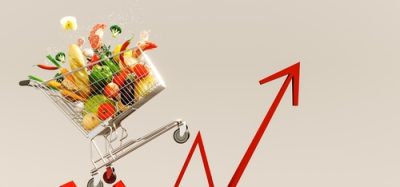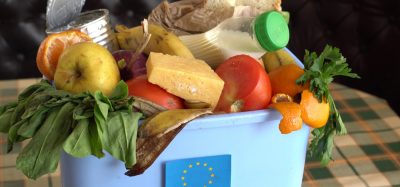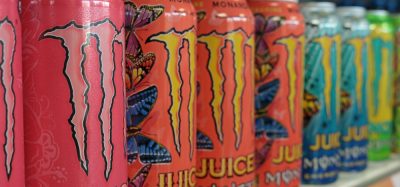Legal necessity or an essential tool for improving profits?
Posted: 12 May 2010 | Kathryn Anne-Marie Donnelly, Norwegian Institute of Food, Fisheries and Aquaculture Research - Nofima | No comments yet
Traceability is gaining importance in order to satisfy legal, consumer and supply chain demands. Traceability of seafood is now recognised as being of particular importance due to the harvesting of wild fish. The Norwegian Institute of Food, Fisheries and Aquaculture Research (Nofima) covers all food sectors and links in the value chain and plays a central role in various international food traceability and standardisation activities, especially related to seafood traceability.
Traceability is gaining importance in order to satisfy legal, consumer and supply chain demands. Traceability of seafood is now recognised as being of particular importance due to the harvesting of wild fish. The Norwegian Institute of Food, Fisheries and Aquaculture Research (Nofima) covers all food sectors and links in the value chain and plays a central role in various international food traceability and standardisation activities, especially related to seafood traceability.
Traceability is gaining importance in order to satisfy legal, consumer and supply chain demands. Traceability of seafood is now recognised as being of particular importance due to the harvesting of wild fish. The Norwegian Institute of Food, Fisheries and Aquaculture Research (Nofima) covers all food sectors and links in the value chain and plays a central role in various international food traceability and standardisation activities, especially related to seafood traceability.
Production of seafood has undergone considerable change during the past century. New food production practices, handling and processing techniques have been developed to meet the increasing consumer demand for reliable and consistently safe supply of various food products. Consumers are giving markedly more emphasis to high quality, sustainability and safety of seafood products. This has resulted in an increasing development of systems to improve information flow and thereby seafood traceability. Development of integrated systems for information exchange in food supply chains has gained considerable importance.
Traceability is not the product and process information itself, but a tool that makes it possible to find this information again at a later date. The concept can be summarised as follows: each link in the supply chain records what it is doing, relates it to ‘that which is under consideration’ and provides a mechanism for getting access to these recordings at a future date. Definitions of traceability vary, particularly with regards to the depth and detail of the traceability system.
In order to examine the current status of traceability, research has been carried out within the fisheries sector. Figure 1 illustrates the results from three studies. Study one (1), carried out in Norway in 20062 on fish products, showed that over 60 per cent of the products could be traced back to boats or fish farm of origin. Study two (2) was carried out in the Nordic countries (Norway, Faroe Islands, Denmark, Finland and Iceland), in 2006-073 and showed that a little over half of the products could be traced back to the boat or farm of origin. In the third study (3), the fisheries results from a larger study carried out in 20094 are presented. These results show that over half the fisheries products could be traced back to their origin. In this study, the products were from across Europe and some were even sourced in the US. Each of the studies in Figure 1 was carried out from within the EU.
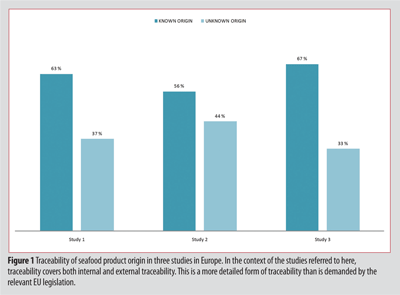

It can be seen from the studies presented in Figure 1 that many seafood producing supply chains have the ability to trace food through their supply chains from supermarket to origin. There was a great deal of variation in the way in which the studies categorised ‘traceable’ but in each case it was a degree of traceability more detailed than that required by the current EU legislation. In many cases, the authors report that they were able to trace to the farm or boat (or a pair of boats) of origin and in some cases the traceability was down to a set of boats. This was very much dependant upon the type of boat and type of fishing equipment used. Some boats, like freezer trawlers, could deliver large amounts of product in one ‘batch’ while in other cases, the catch from several much smaller boats would be mixed during the first stage of production. What the studies also show is that there are many companies (a little under 50 per cent) who have not yet implemented traceability at this more advanced level. Why is this and what are the advantages and disadvantages of traceability? What are the motivational factors?
The motivational factors for implementation traceability5 are presented in Figure 2 and are relevant for the fisheries sector, particularly the focus on documenting sustainability and certification.
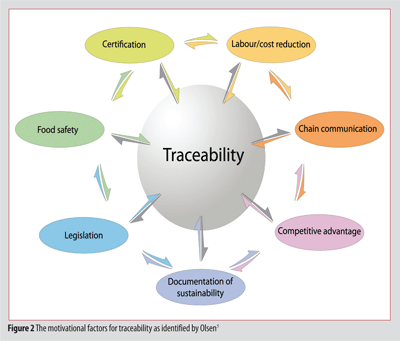

In 2010, the EU introduced the catch certification scheme for fish. It’s aim is to deal with the problems of Illegal, Unregulated and Unreported fishing (IUU) which threatens the sustainability of fisheries. The catch certificate regulation also comprises provisions for port state control, mutual assistance and the establishment of a Community alert system, a Community IUU vessels list and a list of non cooperating third countries. The need for traceability systems has grown with the requirements for the catch certificate together with the multitude of other certification schemes such as Marine Steward Certificate (MSC) and Friends of the Sea.
In light of these motivational factors, particularly food safety and chain communication, one of the areas that the TRACE project focused upon was the fisheries sector. The recently completed EU project TRACE – ‘tracing the origin of food’ aimed to improve the health and well-being of European citizens by delivering improved traceability of food products along entire ‘farm to fork’ food chains. The seafood and fisheries sector has already received attention as it is a sector characterised by a high degree of international trade import and export being a recognised motivational factor for traceability. Research had already been carried out regarding information exchange at an international level with the TraceFish project in 2002. The aim of the TraceFish projects was to create CEN (European Committee for Standardisation) standards for electronic information exchange of information. Efficient storage and retrieval of information related to food products, including information related to all the actors in the supply chain, and food-lot activities such as storage, handling, processing, distribution, etc. which are very important in developing an effective food safety and traceability system. The next step in this process is the development and implementation of international models and standards for information exchange.
The results of the TRACE project showed that companies were implementing traceability not only for certification reasons but also in order to secure a high market share and customers within the supply chain. The main motivation for traceability on the fishing vessel studied was to improve market access and to achieve better production control. On board the fishing vessel, traceability has reduced the work load by making information registra- tion automatic, for example, previously a registration was made in one paper log and then transported to another areas on the boat and re-registered, now it only has to be registered once electronically. Another feature of the system was that information related to the type of trawl and place of the catch was automatically linked to other information related to the catch and then made available through the company’s webpage. If a customer uses the identification number which was printed on the label on each of the frozen blocks of fish, this information could be retrieved at the click of a button. This increased level of traceability has been shown to secure the company contracts and greater market share. Therefore, from this fishing company’s point of view, the traceability system has had numerous benefits. The fishing vessel studied chose to take more detailed steps than that required for an EU catch certificate. Another interesting point is that currently, the information gathered is not actually used in marketing of products. Although the study referred to here is of one vessel, it is thought that the same or similar advantages will be gained across the fisheries sector. The fact that the system is in place and working is enough to secure the advantage. It is thought that over time, this will change as more companies implement ever more detailed internal traceability solutions. As more companies implement the systems, the type and amount of information will become more decisive.
In conclusion, it is becoming apparent that using traceability in a more detailed form than is required by legislation is becoming a commercial imperative and appears to offer a competitive advantage to any company implementing it. From the research presented in Figure 1, it is clear that implementation at this more detailed level is certainly not yet universal and there is still time to use it as an essential tool for improving profits.
References
- ISO. Quality management systems – Fundamentals and vocabulary http://www.iso.org/iso/catalogue_detail?csnumber=42180 downloaded 11.52 18.12.2007. 1994 [cited 2007 11.52 CET 18.12.2007]; http://www.iso.org/iso/catalogue_detail?csnumber=42180]. Available from: http://www.iso.org/iso/catalogue_detail?csnumber=42180.
- Karlsen, K.M. and G. Senneset, Traceability: Simulated recall of fish products, in Seafood Research from fish to dish, Quality, safety and processing of wild and farmed fish., J. Luten, et al., Editors. 2006, Wageningen Academic Publishers the Netherlands. p. 251-262.
- Randrup, M., et al., Simulated recalls of fish products in five Nordic countries. Food Control, 2008. 19(11): p. 1064-1069.
- Donnelly, K. A-M., K.M. Karlsen, and B. Dreyer, Simulated Recalls of Food Products. Food Control Submitted.
- Olsen, P., Food Traceability Process Mapping. Standard methods for analyzing material flow, information flow and information loss in food supply chains, in (2009) Harmonizing methods for food traceability process mapping and cost/benefit calculations related to implementation for electronic traceability systems Nofima report 15/2009. , K. A-M. Donnelly and P. Olsen, Editors. 2009, Nofima – Norwegian Institute of Food Fisheries and Aquaculture: Tromsø.
For a complete reference list, please contact the author.
Issue
Related topics
Related organisations
Fisheries and Aquaculture Research (Nofima), Norwegian Institute of Food




